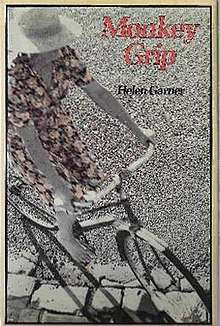Monkey Grip (novel)
Monkey Grip is a 1977 novel by Australian writer Helen Garner, her first published book. It initially received a mixed critical reception, but has now become accepted as a classic of modern Australian literature. The novel deals with the life of single-mother Nora, as she narrates her increasingly tumultuous relationship with a flaky heroin addict, juxtaposed with her raising a daughter while living in share houses in Melbourne during the late 1970s. A film based on the novel, also titled Monkey Grip, was released in 1982. In the 1990s, when critics identified the Australian literary genre of grunge lit, the book was retrospectively categorized as one of the first examples of this genre.
 First edition | |
| Author | Helen Garner |
|---|---|
| Country | Australia |
| Language | English |
| Publisher | McPhee Gribble |
Publication date | 16 September 1977 |
| Media type | |
| Pages | 245 |
| ISBN | 0-14-004953-3 |
| OCLC | 11950836 |
| 823 19 | |
| LC Class | PR9619.3.G3 M6 1984 |
| Followed by | Honour & Other People's Children |
The novel, published at the height of a burgeoning counterculture movement and bohemia scene in Melbourne, achieved some degree of notoriety for its astute, uncompromising depiction of heroin addiction, sexuality, relationships and love. It became recognised as being one of Australia's "first contemporary novels", and long since its initial publication, has come to be regarded as being the "voice of a generation".[1] Furthermore, it helped establish the career of Helen Garner, who is now one of the most well-known writers in Australia.[2] Garner later admitted that there was an autobiographical element to the novel, with much of its plot being diaristic and based on her own experiences.[3][4]
Despite dividing critics after its publication in 1977, the book sold very well.[5] It was one of the first majorly successful works released by Melbourne publishing house McPhee Gribble. In 2018, Monkey Grip was selected by the British Broadcasting Corporation (BBC) as number 47 of a list of "100 stories that shaped the world" – the only Australian novel on the list.[6]
Plot summary

The novel is set in the inner city suburbs of Melbourne in the mid 1970s. The characters inhabit a lively social circle, frequenting cafés, restaurants, cinemas, theatres, pubs and clubs in the city. Nora, a single mother in her thirties, and her young daughter Grace, live in a succession of share houses. Nora is in love with the notoriously unreliable Javo, a twentysomething heroin addict, who repeatedly drifts in and out of Nora's life.[7] Other characters, including Rita, a single mother and Nora's housemate, Gerald, Francis, Joss, Bill, Willy, Claire, and Martin (a former flame of Nora's), also drift in and out of the story. Most of the characters are artists, actors and creative types; many of them frequent the Fitzroy baths in summer. Nora, a freelance journalist, takes small acting gigs in independent films and edits a women's newspaper between jobs to make ends meet.
Nora's relationship with the flaky Javo is first put under strain when he is arrested in Bangkok for drug possession. As he returns, their relationship seems to ebb and flow: while, at a high point, the tentative couple, along with Nora's daughter Grace, go on trips across the country – first to Hobart, then a road trip to Sydney – at its lowest point, Javo steals from the share house to support his heroin habit and disappears for days on end, leaving Nora to wonder about his whereabouts and contemplate his return.
As their relationship intensifies, Nora questions how much of herself will be left if she is wrenched away by a love that is doomed to end. As their relationship approaches eventual disintegration due to Javo's drug addiction, deception, and unsavoury behaviour, Nora takes a short trip to Anglesea to clear her mind. Around this time, Javo seduces Nora's friend Claire, while Nora – drained and depersonalised from their relationship – returns home, forced to start anew and contemplate her feelings about their fleeting, destructive love affair.
Publication and title

Much of the novel was based on Helen Garner's own experiences living in sharehouses in Fitzroy and Carlton in the mid 70s – the relationship between Nora and Javo is based on a relationship Garner had during her time living in sharehousing while raising her daughter. Most of the novel was written in the Latrobe Reading Room at the State Library of Victoria.
Upon completion, Garner took a manuscript to Colin Talbot at Outback Press.[8] This early draft did not feature the love story between Nora and Javo.[8] Talbot suggested Garner try to shape her writing into a narrative, fleshing out certain relationships she had written about. After making significant changes by inserting the romantic relationship between Nora and Javo, Garner finally sent a copy to McPhee Gribble, an independent publishing house in Melbourne run by two women, after it was rejected by one male editor at a large Melbourne publishing house for being "too emotional".[9][10]
Di Gribble of McPhee Gribble, the book's first publisher, wrote that the title of the novel referred to both a linking of hands and the monkey on your back of drug addiction.[11]
Themes
Kerryn Goldsworthy writes that almost all of Garner's fiction addresses "the relationship between sexual behaviour and social organisation; the anarchic nature of desire and the orderly face of the institution of 'family'".[12] The plot point of Nora's obsessive love for Javo is matched by Javo's addiction to heroin – although the source of obsession is different for both people, it possesses a similarly destructive power over a person.
Writer Jean-François Vernay opined in his book A Brief Take on the Australian Novel (2016) that though Garner was writing about a love affair, the novel, as well as the grunge literary genre it heralded, is not about love but rather "the disintegration of love", exploring the lives of alienated or romantically cynical city-dwellers who, in an attempt to escape the stressors and boredom of modern city life, indulge in reckless sexual behaviour which only provides them instant, short lived gratification over long-term meaningful, fulfilling couplings.[13]
The book makes numerous references to the sacred Chinese divination text I Ching, which Nora consults several times for guidance on her relationship with the unstable Javo.
Critical reception
Monkey Grip initially met with a mixed reception in Australia.[14] Some critics praised Garner's writing, including Peter Corris, who called the writing "attractive and accessible, a pleasure to read" and further commented "[Garner] has the ability to capture movement and stillness and light and sound with words which belong to writers like E.M. Forster and, to give a different but appropriate example, Jack Kerouac".[15] Since its release it has come to be regarded as a classic of modern Australian literature.[16]
In 1978, Garner was awarded the Book of the Year Award by the National Book Council for Monkey Grip – making her the first woman in Australia to win the award.[17] The panel acknowledged that it was "not an easy choice", given that the book's subject matter included "heroin addiction, inner-city communal living and obsessional love".[17] They further stated that the central character, Nora, is "superbly realised in her hesitancies and enthusiasms", that the book was "beautifully constructed", and that Garner had been "utterly honest in demonstrating the dilemmas of freedom, and particularly of social and sexual freedom for women trying to create for themselves a role which will recognise their full humanity".[17]
The novel was released internationally in Europe and the United States in the late 1970s and early 1980s.[18] It was met with a modest acclaim there – with the London Times writing "the actual force of the author's prose carries the novel along like a strong drink" and Vogue similarly praising the book for Garner's "deliberately laconic style", further stating she "renders her experiences with imagination to produce a novel that is chilling to read, cut and coloured with hard energy and strong feeling".[19]
Legacy
Charlotte Wood in a foreword to the 2018 edition
In 1980, Monkey Grip was serialised for the Melbourne community radio station 3RRR with Garner reading the entire text of the novel on air, herself.[20]
It has been translated into several languages, including French and Italian.[17] By the time of the release of the film adaptation, the novel had sold in excess of 100,000 copies.[17] It has been taught in both high schools and universities.[15][21]
In 2018, the book was voted number 47 on a list of 100 stories that changed the world, "stories they felt had shaped mindsets or influenced history",[22] by a survey of 108 "critics, scholars and journalists" polled by the BBC.[23] During that same year, it was republished in a fortieth anniversary hardcover edition by Text Publishing, with an introduction by Charlotte Wood.[24]
Helen Garner’s Monkey Grip is an award winning ABC TV documentary by writer and director Fiona Tuomy. The film explores the real people and events behind Helen Garner’s groundbreaking debut novel Monkey Grip and the impact it had on Australia’s artistic, political and cultural identity.
Movie adaptation
In 1982, the novel was adapted to the film Monkey Grip directed by Ken Cameron from his own screenplay. The lead actors were Noni Hazlehurst as Nora and Colin Friels as Javo.
References
- "Helen Garner's Monkey Grip". ABC. 1 October 2014. Retrieved 3 September 2017.
- "Helen Garner on murderer Robert Farquharson". The Australian. 25 March 2017. Retrieved 3 September 2017.
- Bennett, Tegan (3 November 2012). "A phone call to Helen Garner". The Australian. Retrieved 26 December 2017.
- Rooney, Brigid (2009). Literary Activists: Writer-intellectuals and Australian public life. University of Queensland Press. p. 154. ISBN 9-78070224-143-7.
- "Helen Garner's Monkey Grip makes me examine myself". The Guardian. 25 October 2018. Retrieved 31 October 2018.
- "The 100 stories which shaped the world". BBC. 22 May 2018. Retrieved 23 July 2018.
- Tegan Bennett Daylight (3 November 2012). "A phone call to Helen Garner". The Australian. Retrieved 13 April 2016.
- Brennan 2017, p. 43
- "Helen Garner on Monkey Grip's diaristic birth". YouTube. 25 August 2013. Retrieved 30 September 2018.
- "Friday essay: the remarkable, prize-winning rise of our small publishers". The Conversation. 4 May 2018. Retrieved 4 May 2018.
- Frizell, Helen (13 October 1978). "The year's best books – 1. Helen Garner's Monkey Grip". The Sydney Morning Herald. Retrieved 13 April 2016.
- Goldsworthy, Kerryn (1996) Australian Writers: Helen Garner, Melbourne, Oxford University Press, p. 28
- Vernav, Jean-François (2016). A Brief Take on the Australian Novel. Wakefield Press (Adelaide, South Australia). p. 127. ISBN 978-1-74305-404-8.
- Goldsworthy (1996) p. 1
- Brennan 2017, p. 45
- Monkey Grip, Penguin Classics
- Brennan 2017, p. 48
- "Paradise, Australian style". The New York Times. 4 April 1982. Retrieved 10 February 2018.
- Monkey Grip (First US ed.). New York: Seaview Books. 1977. ISBN 9-780-87223677-6.
- "Monkey Gripping Radio". National Film and Sound Archive. Retrieved 12 November 2018.
- Daylight, Tegan Bennett (24 December 2017). "'The difficulty is the point': teaching spoon-fed students how to really read". The Guardian. Retrieved 29 December 2017.
- "The 100 stories that changed the world". BBC Online. 22 May 2018. Retrieved 28 May 2018.
- "The 100 world-shaping stories: who voted?". BBC Online. 22 May 2018. Retrieved 28 May 2018.
- "Text Publishing - Monkey Grip, book by Helen Garner". Text Publishing. Retrieved 12 November 2018.
Bibliography
- Brennan, Bernadette (2017). A Writing Life: Helen Garner and Her Work. Text Publishing. ISBN 9-78192541-039-6.CS1 maint: ref=harv (link)
External links
- "Helen Garner's Monkey Grip", documentary about background and impact of the book
- Monkey Grip, including an extract, Penguin Books Australia